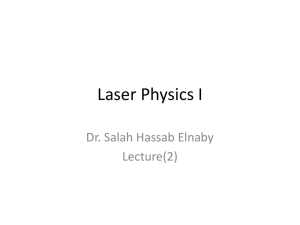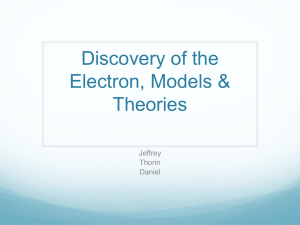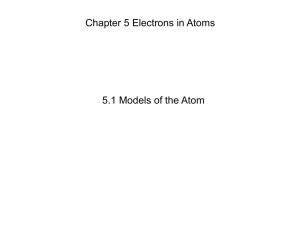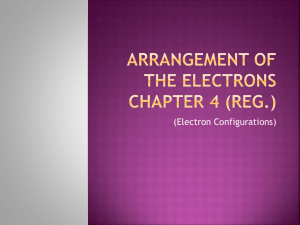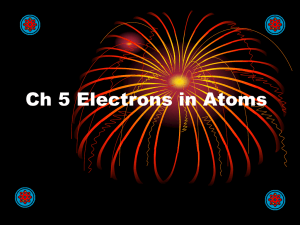Chapter One
advertisement
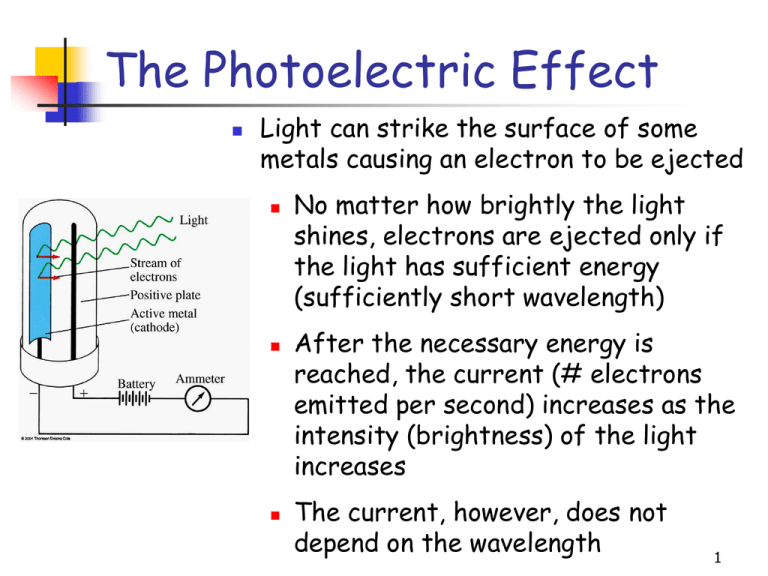
The Photoelectric Effect Light can strike the surface of some metals causing an electron to be ejected No matter how brightly the light shines, electrons are ejected only if the light has sufficient energy (sufficiently short wavelength) After the necessary energy is reached, the current (# electrons emitted per second) increases as the intensity (brightness) of the light increases The current, however, does not depend on the wavelength 1 The Photoelectric Effect 1905 – Albert Einstein Explained photoelectric effect (Nobel prize in physics in 1921) Light consists of photons, each with a particular amount of energy, called a quantum of energy Upon collision, each photon can transfer its energy to a single electron The more photons strike the surface of the metal, the more electrons are liberated and the higher is the current 2 Emission and Absorption Spectra When electric current passes through a sample of gas at very low pressure, light is emitted The picture obtained is called an emission spectrum An absorption spectrum is formed by shining a beam of white light through a sample of gas Every element has a unique emission or absorption spectrum 3 Balmer-Rydberg Equation An empirical equation that relates the wavelengths of the lines in the hydrogen spectrum 1 1 1 R 2 2 n1 n2 n1 n2 R 1.097 107 m-1 - the Rydberg constant n’s refer to the numbers of the energy levels in the emission spectrum of hydrogen Balmer-Rydberg equation suggested that atoms have more complex underlying structure 4 Rydberg Equation: Example What is the wavelength of light emitted when the hydrogen atom’s energy level changes from n = 4 to n = 2? 5 Bohr’s Atom Rydberg equation suggested that atoms have more complex underlying structure 1913 – Neils Bohr Applied Planck’s quantum theory to explain the hydrogen spectrum (Nobel prize in physics in 1921) 6 Postulates of Bohr’s theory Atom has a number of discrete energy levels (orbits) in which an electron may revolve without emitting or absorbing electromagnetic radiation. As the orbital radius increases so does the energy of the electron 7 Postulates of Bohr’s theory An electron may move from one energy level (orbit) to another, but, in so doing, monochromatic radiation is emitted or absorbed in accordance with the following equation E2 - E1 E h hc E2 E1 8 Atomic Spectra and the Bohr Atom Light of a characteristic wavelength (and frequency) is emitted when the electron moves from higher energy level (larger n) to lower energy leverl (smaller n) This is the origin of emission spectra Light of a characteristic wavelength (and frequency) is absorbed when the electron moves from lower energy level (smaller n) to higher energy leverl (larger n) This is the origin of absorption spectra 9 Postulates of Bohr’s theory An electron revolves in a circular orbit about the nucleus and its motion is governed by the ordinary laws of mechanics and electrostatics, with the restriction that its angular momentum is quantized (can only have certain discrete values) angular momentum = m·v·r = nh/2 m = mass of electron v = velocity of electron r = radius of orbit n = 1,2,3,4,...(energy levels) h = Planck’s constant 10 Bohr’s Theory Bohr’s theory correctly explained the hydrogen emission spectrum The theory failed for all other elements with more than 1 electron Bohr’s theory attempted to use classical mechanics to solve a problem that could not be solved by classical mechanics 11 Wave Nature of the Electron 1925 - Louis de Broglie (Nobel prize in physics in 1929) Not only electromagnetic waves can be sometimes considered as particles (photons) Very small particles (electrons) might also behave as waves under the proper circumstances h mv Planck’s constant mass and velocity of the particle 12 Wave Nature of the Electron How to prove this experimentally? Every wave should exhibit the phenomena of interference and diffraction 13 Wave Nature of the Electron De Broglie’s assertion was verified by Davisson & Germer within two years: They demonstrated that a beam of electrons can diffract through a crystal of nickel Today we now know that electrons (in fact - all particles) have both particle- and wave-like character This wave-particle duality is a fundamental property of submicroscopic particles. 14 Wave-Particle Duality Determine the wavelength, in m, of an electron, with mass 9.11 x 10-31 kg, having a velocity of 5.65 x 107 m/s 15 Wave-Particle Duality Determine the wavelength, in m, of a 0.22 caliber bullet, with mass 3.89 x 10-3 kg, having a velocity of 395 m/s 16 Heisenberg Uncertainty Principle 1927 - Werner Heisenberg (Nobel prize in physics in 1932) Developed the concept of the Uncertainty Principle It is impossible to determine simultaneously both the position and momentum of an electron (or any other small particle) 17 Schrödinger Equation 1926 – Erwin Schrödinger (Nobel prize in physics in 1933) Demonstrated that the small particles should be described in terms of probability theory 2 2 2 h 2 2 2 2 V E 8 m x y z 2 We cannot determine precisely the position of the electron but we can determine the probability of electron being present in certain region of space 18 The Quantum Mechanical Picture of the Atom Electrons can occupy only discrete energy levels with certain amount of energy When an electron changes its energy state, it must emit or absorb just enough energy to bring it to the new energy state (the quantum condition). E E2 - E1 h hc 19 The Quantum Mechanical Picture of the Atom The allowed energy states of atoms and molecules can be described by sets of numbers called quantum numbers Quantum numbers emerge from the solutions of the Schrödinger equation Four quantum numbers are necessary to describe energy states of electrons in atoms: n m ms 20 Quantum Numbers n - the principal quantum number Allowed values n = 1, 2, 3, 4, ...... “shells” n = K, L, M, N, ...... - the angular momentum quantum number Allowed values = 0, …, n – 1 “subshells” = s, p, d, f, ...... 21 Quantum Numbers and Orbitals n + Define the energy of the electron Defines the shape of the orbital Orbital The volume around the nucleus where the electron appears 90-95% of the time. 22 Quantum Numbers m - the magnetic quantum number Allowed values m = –, – + 1, – + 2, … , – 2, – 1, Defines the orientation of the orbital 23 Quantum Numbers ms - the spin quantum number Allowed values ms = –½, +½ Defines the orientation of the magnetic field generated by the electron 1925 - Wolfgang Pauli (Nobel prize in physics in 1945) Formulated Pauli Exclusion Principle Any electron can have only one unique set of the four quantum numbers 24 s orbital ( = 0) 25 p orbital ( = 1) There are 3 p orbitals per n level They are named px , py , and pz 26 d orbital ( = 2) There are 5 d orbitals per n level 27 f orbital ( = 3) There are 7 f orbitals per n level 28
